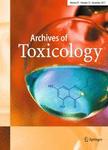版权所有:内蒙古大学图书馆 技术提供:维普资讯• 智图
内蒙古自治区呼和浩特市赛罕区大学西街235号 邮编: 010021

作者机构:Univ Munich Inst Cardiovasc Prevent Pettenkoferstr 9b D-80336 Munich Germany Bundeswehr Inst Pharmacol & Toxicol Munich Germany Univ Munich Walther Straub Inst Pharmacol & Toxicol D-80336 Munich Germany German Sport Univ Cologne Mol & Cellular Sport Med Cologne Germany
出 版 物:《ARCHIVES OF TOXICOLOGY》 (毒理学文献)
年 卷 期:2016年第90卷第5期
页 面:1141-1150页
核心收录:
学科分类:1007[医学-药学(可授医学、理学学位)] 1001[医学-基础医学(可授医学、理学学位)] 10[医学]
基 金:Institute of Cardiovascular Prevention, Ludwig-Maximilians-University of Munich German Armed Forces [M/SABX/BA003]
主 题:VEGF-A BNIP3 MMP-2 IOX2 Wound healing Scratch assay
摘 要:Skin exposure to sulfur mustard (SM) provokes long-term complications in wound healing. Similar to chronic wounds, SM-induced skin lesions are associated with low levels of oxygen in the wound tissue. Normally, skin cells respond to hypoxia by stabilization of the transcription factor hypoxia-inducible factor 1 alpha (HIF-1 alpha). HIF-1 alpha modulates expression of genes including VEGFA, BNIP3, and MMP2 that control processes such as angiogenesis, growth, and extracellular proteolysis essential for proper wound healing. The results of our studies revealed that exposure of primary normal human epidermal keratinocytes (NHEK) and primary normal human dermal fibroblasts (NHDF) to SM significantly impaired hypoxia-induced HIF-1 alpha stabilization and target gene expression in these cells. Addition of a selective inhibitor of the oxygen-sensitive prolyl hydroxylase domain-containing protein 2 (PHD-2), IOX2, fully recovered HIF-1 alpha stability, nuclear translocation, and target gene expression in NHEK and NHDF. Moreover, functional studies using a scratch wound assay demonstrated that the application of IOX2 efficiently counteracted SM-mediated deficiencies in monolayer regeneration under hypoxic conditions in NHEK and NHDF. Our findings describe a pathomechanism by which SM negatively affects hypoxia-stimulated HIF-1 alpha signaling in keratinocytes and fibroblasts and thus possibly contributes to delayed wound healing in SM-injured patients that could be treated with PHD-2 inhibitors.